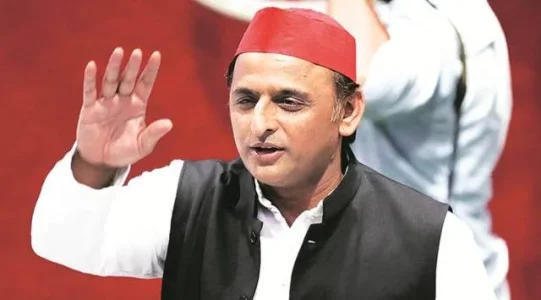In 14 terror cases SP govt wanted to drop, acquittal in 8, conviction in 4
With BJP accusing the previous Samajwadi Party govt of withdrawing terror cases, Manish Sahu pieces together all the 14 cases, and what happened to the move of withdrawing them.
Written by
Manish Sahu
Lucknow | Updated: February 22, 2022 14:59 IST
8 min read

The SP government decided to withdraw 14 such cases in which 19 people – all from UP and West Bengal — were accused.
A year after coming to power in UP in 2012, the Samajwadi Party (SP) government of Akhilesh Yadav decided to withdraw terror cases as promised in its poll manifesto. The SP government decided to withdraw 14 such cases in which 19 people – all from UP and West Bengal — were accused.
However, the Allahabad High Court stayed the state government’s move after hearing a PIL filed by a lawyer, Ranjana Agnihotri, and five others. Agnihotri’s lawyer Hari Shankar Jain said that the then SP government had filed a Special Leave Petition (SLP) in the Supreme Court against the High Court’s stay order, and it is still pending.
Also Read |
‘Cycle & bombs’: PM Modi targets Samajwadi Party on terror, says it withdrew cases against accused
In the meantime, the trial in eight of the 14 terror cases ended in acquittal either for lack of evidence or the judge giving the accused the benefit of doubt. In four others, the courts have convicted the accused. The trial in one of the cases is still going on, and in the last case, the accused is still on the run.
The Indian Express lists the 14 cases below.
Cases 1 & 2
Accused: Yakoob
Story continues below this ad
UP Police arrested Yakoob, a resident of Bijnor, from
Lucknow on June 21, 2007, for allegedly supplying RDX in different parts of the country. Police claimed to have recovered explosives from his possession and alleged that he was an operative of a terror outfit — HuJI. He was booked in two terror cases along with two others — Naushad Hafiz and Jalaluddin. The cases were registered at Hussainganj Police Station in Lucknow.The SP government had sought to drop the charge against Yakoob only.
Eight years later – on August 6, 2015 — a Lucknow court acquitted Yakoob and the two others on benefit of doubt.
Cases 3&4
Accused: Nasir Hussain
Nasir Hussain, a resident of Bijnor, was arrested from a hotel in Lucknow in June 2007. Police claimed to have recovered RDX and detonators from his possession. Two FIRs were registered against him at Naka Hindola Police Station in Lucknow.
On March 20, 2014, a Lucknow court acquitted Nasir for lack of evidence.
His lawyer, Syed Ahsan Abbas Rizvi, had said that a seer — Swami Shivanand — who runs an ashram in Uttarakhand’s Tehri Garhwal district, gave a statement in the court stating that Nasir was a part of a construction work team at his ashram when the police “picked” him on June 19, 2007. He added that the police theory was wrong as their record stated he was arrested from Lucknow on June 21. Referring to Shivanand’s statement and the police’s claim, the court observed that whenever two possibilities arise, the benefit of doubt must go to the accused.
Case 5
Accused: Mohammad Kaleem, Syed Abdul Mobeen
The two were booked in connection with a blast that took place near Sahkarita Bhawan in Lucknow on August 15, 2000. While there was no human casualty, the explosion had left a breach in a wall and some window panes shattered.
A terror case was filed at Qaiserbagh Police Station in Lucknow against the two. Mohammad Kaleem and Syed Abdul Mobeen are residents of UP.
April 10, 2014, the trial court acquitted the three by giving them the benefit of doubt.
Case 6
Accused: Mukhtar Hussain, Mohammad Ali Akbar, Ajijur Rehman, Naushad Hafiz & Noor Islam
The five undertrials were booked for allegedly raising anti-national slogans when they were produced before a court in Lucknow on August 13, 2008. Except for Naushad, others were residents of West Bengal. They were arrested in 2007 for allegedly planning a blast in Lucknow.
The SP government had sought withdrawal of the case in which they were booked for allegedly raising anti-national slogans. On January 14, 2016, a Lucknow court acquitted all the five in the sloganeering case. They were later acquitted in the terror case also.
Case 7
Accused: Maqsood, Javed & Taj Mohammad
Rampur police arrested Maqsood, Javed, Taj Mohammad and Mumtaz Mian on August 13, 2002, for allegedly leaking Indian military secrets to Pakistan. Police claimed that they gave away vital information about the army’s movement and claimed to have found military installation maps of several places, including that of Dehradun and Meerut, from their possessions. Police also invoked the Prevention of Terrorism Act (POTA) against three. All the four are residents of Rampur. The case was transferred to Moradabad after POTA was invoked.
The SP government had decided to drop the charge against Maqsood, Javed, Taj Mohammad.
On January 20, 2014, the court acquitted the four for want of evidence.
Case 8
Accused: Ahmed Hasan
Ahmed Hasan, a truck driver, and his neighbour Wasif were arrested in Bijnor on June 21, 2002, for allegedly spying for Pakistani agencies. They were booked on various charges, including Officials Secret Act.
Case 9
Accused: A juvenile
After four policemen were injured in a blast in Arya Nagar area of Kanpur on August 14, 2000, 10 persons, including a juvenile, were booked under the Explosives Act and on charges of attempt to murder, sedition, and waging war against the state. One of the accused was gunned down in an encounter in Kashmir in 2005.
A local court in Kanpur acquitted the eight accused, who were major, for lack of evidence. However, the trial of the remaining accused, a juvenile, continued. The SP government had wanted the withdrawal of the case against the juvenile.
As per the juvenile’s lawyer, Azizul Rehan, the trial is still pending before the Juvenile Justice Board, and the statements of 12 prosecution witnesses have been examined so far.
Case 10
Accused: Imtiyaz Ali
Imtiyaz Ali, a resident of Jhansi, was arrested from Kanpur in September 2009 for allegedly spying for Pakistan’s intelligence agency.
Police had claimed that he was on their payroll was assured Rs 5,000 monthly pay by the ISI. Police had then claimed to have recovered eight SIM cards and documents containing details of the Indian Army from his possession.
Ali was convicted in 2017 and sentenced to 13 years of imprisonment. His lawyer said that an appeal has been filed in the Allahabad High Court against the trial court’s verdict.
Case 11 & 12
Accused: Mohammad Tariq Qasmi
The SP government had decided to withdraw two cases filed against Tariq Qasmi, a resident of Azamgarh, in Barabanki and Gorakhpur.
Qasmi was arrested with his associates Khalid Mujahid from Barabanki on December 20, 2007, allegedly with explosives. He was later booked for May 2007 Gorakhpur serial blasts case in which six people were injured.
While Khalid Mujahid died in 2013 during the trial, a Barabanki court awarded Qasim life imprisonment in April 2015. In December 2020, a Gorakhpur court also sentenced Qasmi to life imprisonment in the blast case. He has also been awarded life imprisonment for the Lucknow and Faizabad court blasts in which five persons were killed.
His lawyer said that pleas against the lower court verdict are pending in the High Court.
Case 13
Accused: Sitara Begum
Sitara Begum, a resident of Auraiya, was arrested in August 2010 for allegedly giving shelter to Pakistani citizen Waqas Ahmed.
Police claimed that Waqas was a Pakistani spy and was passing information about Indian military installations to the ISI since 2005. He had married Sitara’s daughter.
Sitara was accused of helping prepare a fake voter identity card for Waqas.
In April 2017, a Kanpur court convicted Sitara and sentenced her to six years and 10 months’ imprisonment. The court also awarded 10 years of jail to Waqas.
Case 14
Accused: Shamim Ahmed alias Sarfaraz
Shamim Ahmed, a resident of Chandauli, was charged for allegedly planting a bomb at a public place in Varanasi in 2006. The bomb, which did not explode, was found soon after March 7, 2006, twin blasts at Sankatmochan Mandir and Varanasi Cantt Railway Station in which 21 people were killed.
All the bombs were made by packing explosives in pressure cookers.
UP STF arrested Waliullah, the imam of a mosque in Prayagraj, on April 5, 2006, and said that he was the mastermind of the blasts.
The police had claimed that the blasts were executed by three men from Bangladesh with whom Waliullah had studied at Deoband.
While Waliullah is currently lodged at Dasna jail in Ghaziabad, the trio was never caught. In December 2006, the police named Shamim in the chargesheet and he too is absconding.













